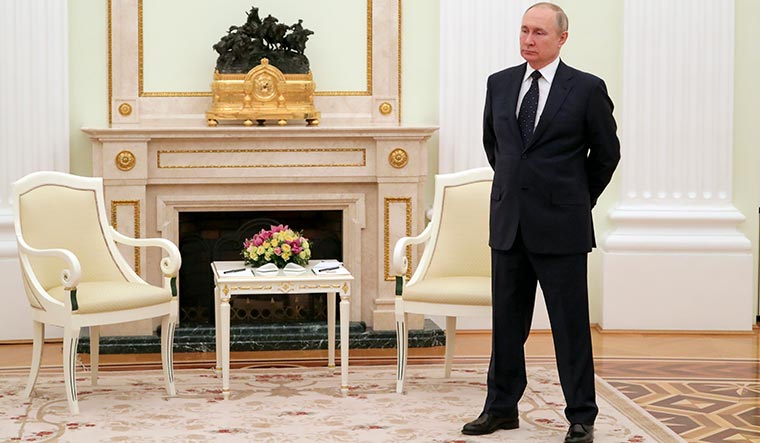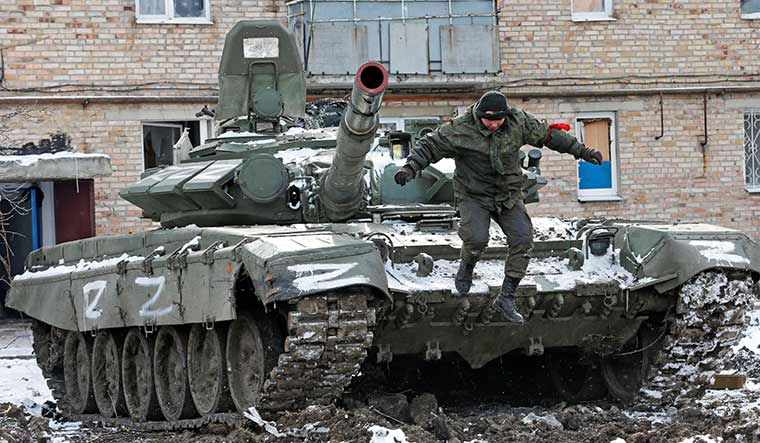ON SUNDAY, MARCH 13, Vladimir Putin’s top aide and chief of Russia’s National Guard, General Viktor Zolotov, made a candid confession at a church service led by Patriarch Kirill, head of the Russian Orthodox Church: “Yes, not everything is going as fast as we would like.” The general was referring to the war in Ukraine, the awesome march of Russian arms, which Putin likes to call a ‘special military operation’.
The western media grabbed it as the first admission by a Russian security czar about the slowness of the operation. They were wrong. The Russian high command had been indicating it in several of their daily briefings. On March 10, the day on which the forces captured Maryanovka, Lazarevka and Lesnoe, defence ministry spokesman Major General Igor Konashenkov admitted: “The march is progressing at about 10km a day.” In the days that followed, the war machine ground down to even 6km a day, though by March 14 it picked up speed upto 10km and, on some fronts, even 14km.
The snail’s pace of the march, already three weeks old and weary, has baffled military observers. “This has not been the operational philosophy of the Russian army,” said an intelligence analyst in Warsaw. “Wherever they have gone in, they had gone for surprise and speed.” Indian generals, too—who contrast the slow march with the Indian Army’s race into East Pakistan culminating in the capture of Dacca in 13 days—are surprised. Their initial assessment was that “perhaps in order to save civilian casualties, Russia’s approach is slow,” said Lt Gen Mohinder Puri, who commanded a division in the Kargil war. Konashenkov’s daily briefings have been indicating the same—that the Russians have been holding fire to save civilians. Every day he has been giving out details of the humanitarian corridors that had been offered, but often blocked because of alleged Ukrainian intransigence. On March 10, “We allowed ten corridors from Kiev, Chernihiv, Sumy, Kharkiv and Mariupol, through the territories controlled by the Kiev authorities to Poland, Moldova and Romania,” said Konashenkov. “We also proposed one corridor from each city to the Russian Federation, too. But the Ukrainian side agreed on only two—on Kiev and Mariupol directions, and not a single corridor to the Russian Federation.” Such procedural problems are not the only issues that are delaying capture of Kyiv. “Definitely, the Russians have miscalculated the resistance from Ukraine,” said Puri.
“The weapons supplied by NATO and Americans are also adding up,” added Lt Gen D.S. Hooda, former northern army commander who masterminded the surgical strike on Pakistan. Seventeen thousand anti-tank weapons from NATO, which is huge, and probably five times the inventory held by the Indian army. A closer look reveals that it is neither the Ukrainian resistance nor the Russians’ concern for human lives that is slowing down the march. It is poor logistics, bad battle management, wrong use of force and, worst of all, miserable tactics. Apparently, someone up there in the general staff in Moscow, the guys who plan and organise operations, has goofed up.
The results are for all to see. Going even by Konashenkov’s claims, and despite the western TV images of rockets firing and falling on buildings that had been homes and hospitals, the Russians have destroyed very few hard targets. “In every war, you first take out the enemy’s command and control centres, missile batteries, armour and gun concentrations, ammunition depots, radars, airfields, bridges, rail and road hubs so as to cripple the enemy and immobilise him,” explained a three-star general in the Indian army. “Such initial neutralisation is done mostly from the air these days. In the digital era, you also launch a cyber attack to cripple the enemy’s command and communication network, apart from his economy. This yields military dividends and political scoring points—you kill few people, yet achieve your goal.”
Surprisingly, despite Russia’s famous—or notorious—capability to hack into any server in the world, allegedly including the US electoral system, the Russians have done little. Ukraine’s cyber and communication systems are working, after a few hiccups in the initial days.
Going by the pattern of most invading armies, observers had expected Russia to establish air superiority in the first 48 to 72 hours. However, apart from launching missiles at airfields, the Russians did little to cripple the Ukrainian air force. Three weeks into the war, Ukrainian radars, anti-aircraft missiles and guns are alive and shooting.The first signs of major air activity appeared well after two weeks of the war. On the morning of March 15, Konashenkov claimed that Russia had shot down 16 air targets including a Su-24, a Su-25 and a Mi-8 helicopter, plus hitting four anti-aircraft missile systems, and three hangars containing four Su-25 assault aircraft, and a few helicopters.
It has been a sorrier story on the ground. With all its might and fury, the Russians have achieved little in terms of neutralising (military euphemism for destroying) the enemy’s military targets in three weeks—just 1,300 tanks and armoured combat vehicles, 124 rocket launcher systems, 470 artillery guns, 145 UAVs, and about a thousand military vehicles, as on March 15—going by the official version given by General Konashenkov.
Poor battle management and poor logistics have been glaring from the start. The Russians launched their ground offensive on four prongs—the main thrust towards Kyiv from the west, with support from the Chernihiv and Sumy axes from the northeast and east; another towards Kharkiv using 23 combat groups, a third towards Mariupol; and yet another thrust towards Kherson and further westward by three combat groups drawn from 7th Airborne Division. The fourth thrust, by three combat groups of the elite airborne division, was repulsed in the early stage of operation.
Surprisingly, unlike the Indian army that was told to “leave the highways” which may be defended by the enemy, and “take the byways” towards Dacca, the Russians rode their tanks straight down the highways, as if they were on a holiday. “Apparently, they can’t leave the highways because the snow that is melting now in spring would have made the earth slushy, making it impossible for the tanks to move,” pointed out Lt Gen C.A. Krishnan, former deputy chief of Indian Army. Contrast that with Gen Sam Manekshaw’s far-sighted refusal to launch operations till the monsoon-soaked Bengal countryside had dried up by winter. And this was the army that had defeated the grand armies of Napoleon and Hitler by simply bogging them down in snow and slush!
Failure to change tactics and targets has been glaring. After two weeks of slow progress and mounting losses, and having failed to take Kyiv, or even Mariupol which had seemed easy picking, the Russians appear to be opting for siege warfare—cutting supplies to the cities and forcing the defenders to surrender or starve to death. There were reports about frontline battle groups having run out of fuel and food, indicating poor logistics planning. “We hear that the tankers from the rear could not reach the frontline to refuel battle tanks stuck on the highways,” said an analyst in Warsaw. “This wouldn’t have happened if they had opted for a broader front, instead of driving down the highways.” The logistics is reported to have improved after the first week. Two supply convoys are reported to have reached the Kyiv front. Rail deliveries from Russia have improved.
In employment of force, too, the Russians have goofed up. “Russian generals may be battle-scarred veterans, but they are known to employ conscripts in the frontline,” said Lt Gen Philip Campose, former vice-chief of Indian Army. Worse still, there are reports, based on statements by captured Russian troops, that the troops had been told they were being sent for an exercise in Ukraine. They came to know they were in battle only after the first ambushes happened. Battle management has been found wanting. “Every army goes to battle hoping for the best but prepared for the worst,” said Campose. “But here there is no sign of the Russians having prepared for anything more than just walking in and capturing the towns.” The forces seem to be at a loss as to what to do now, except keep on pounding.Three weeks into the war, the military assessment is that the focus has been compressed to two areas of operations—one in the north and the other in the south. Faced with their own logistics problems around Kyiv in the north, more than enemy resistance, the Russians are currently committing more troops and firepower. “But that could also be only a threatening gesture so as to unnerve the defenders,” said an officer. “We don’t believe that they would reduce Kyiv to pulp.”
The offensive in the south appears to be more successful. The supply line from Crimea is running well; the Russians may soon capture Mariupol and Kharkiv and go for Odesa, the prized Black Sea port. But the big question is: when will the higher prized Kyiv fall?
Or would it prove to be a repeat of that gruesome end that visited another invading army a century-and-a-half ago in next-door Crimea, where Lord Cardigan’s Light Brigade charged up to find “cannon to the right of them, cannon to left of them, cannon in front of them, volleying and thundering.” Let us not forget, it was poor generalship that sent the six hundred riding “into the jaws of death, into the mouth of hell”.
—With Pradip R. Sagar



